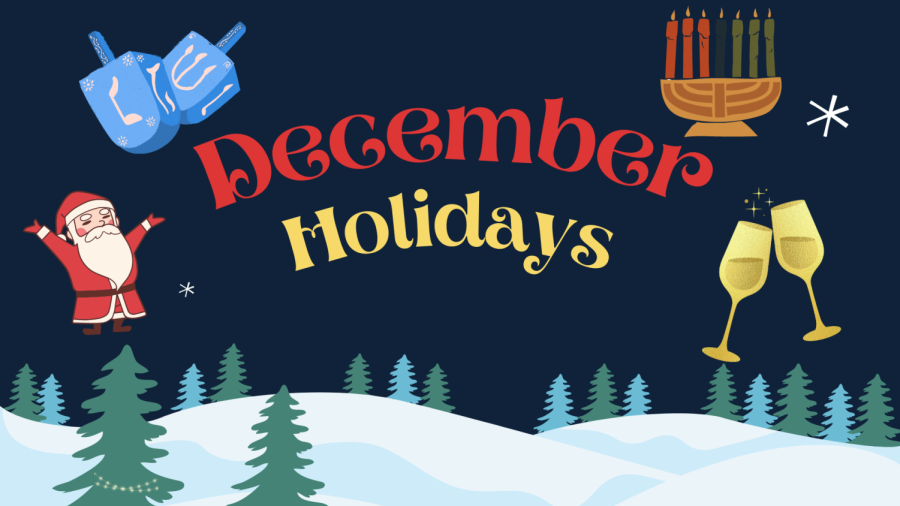December holidays: A season of festivity
Graphic illustration by Samiya Anwar
With lights, candles and tables full of food, December is the heart of the holiday season.
December 12, 2022
Representing lights, candles and tables full of food, December is the heart of the holiday season. From Christmas and Hanukkah to Kwanzaa and New Year’s Eve, families gather to celebrate, honor cultural traditions and usher in a new year.
Christmas
A holiday rooted in Christianity, Christmas is a celebration which commemorates the birth of Jesus Christ. For Christians, Christmas Eve and Christmas Day church services discuss the miracle of the birth of Jesus Christ. Christmas service also opens up donations to give to the poor in a season of celebration.
A typical service includes traditional Christmas carols, stories from the Bible and prayers. Nativity scenes display the story of Jesus Christ’s birth in a stable in Bethlehem and his visits by the shepherds and wise men. With an advent calendar, Christians learn and discuss one aspect each day about Christmas and the story behind the holiday.
For the Polish, Christmas starts with St. Nicholas’ day, observed on Dec. 5 through 6 as a way to celebrate Saint Nicholas’ generosity. Saint Nicholas was known to have given up his inherited money and helped out the poor in the countryside, all in secret. Similarly, gifts are placed under childrens’ beds in early December as a secret gift from Saint Nicholas, kicking off the Christmas season.
“We have a little family tradition as well, where family members make little gifts for each other and leave them under the Christmas tree,” senior Konrad Wrebiak said. “That way, in addition to the traditional ‘Santa Claus gifts’ for the kids, we have a few homemade gifts that serve as a thank you for the past year.”
Gift giving has also extended into secular Christmas traditions as a way for people to show their appreciation to friends and family during the holiday season through Secret Santa or White Elephant. Christmas toy drives such as Toys for Tots and Operation Christmas Child encourage people to donate without expecting anything in return.
“I love [the giving side of Christmas] because it brings my family together and gives us a reason to get together every year,” Leong said. “But there’s also the Christian aspect of it where we get to learn about the miracle of Jesus Christ’s birth and focus on the true meaning of Christmas: that God sent his son to save us from our sins.”
In Poland, gifts appear under the tree once again on Christmas Eve by Santa after St. Nicholas’ day while the Christmas Eve feast is prepared. The feast includes breaking the “opłatek”, a wafer depicting nativity scenes, hay under the table to signify Christ’s birth in the manger, 12 dishes to honor the 12 apostles and an extra plate of food left for any wanderers who may be hungry. Christmas day ends with “Pasterka,” a midnight mass to celebrate the arrival of Jesus Christ.
A popular winter holiday, Christmas always includes staples such as Christmas trees, lights, family gatherings and holiday meals. Neighborhood-wide Christmas decoration displays have become a drive-thru attraction, and annual events like Christmas in the Park in downtown San Jose remain a popular place to celebrate the holiday cheer.
“I personally love that Christmas has morphed into a holiday [that is not only about Jesus Christ],” Leong said. “Even though it may not be exactly how Christmas was originally intended to be, it’s a holiday that really brings families together.”
Hanukkah
Hanukkah, the Jewish “Festival of Lights,” is observed starting from the 25th of Kislev in the Hebrew Calendar. A holiday lasting for eight nights, Hanukkah celebrates the victory of Jews in claiming their home of Jerusalem again.
Hanukkah honors the rededication of Second Temple in Jerusalem after the victory of Maccabeans Jews against the Greeks who tried to hellenize the Jews, forcing them to adopt Greek idol culture and religion. After being exiled, Macabee went to war against the Greeks to fight for the Jews.
“They were outnumbered, they had less equipment, less training and the Greeks also had war elephants and other ancient weapons of that sort,” said Yuval Waizer, Homestead Jewish Student Union officer. “It was really a miracle that they managed to win and beat them back.”
To honor the rededication of Second Temple, Judah called to reinstate the altar and light the menorah. A menorah is a stand with eight candles and is traditionally lit every day with sacred olive oil approved by a High Priest.
In the desecrated temple, there was only enough olive oil found for the candles to burn for a day, yet they burned through eight nights. The miracle started the traditions of celebrating Hanukkah for eight nights.
Today, one additional candle on the candle stand each night. A menorah has space for eight candles, while a Hannukiah, another type of candle stand, has nine candles with the middle candle being lit initially and used to light the others. Prayers are held during the candle lighting each night along with singing traditional Hanukkah songs, and a longer prayer is held on the last night.
“My family lights all but one of the candles at home,” Waizer said. “Usually on the last night, we go over to our cousin’s house, and with some of their friends and family, we have a giant Hanukkah party.”
Foods rich with oil are traditional meals to celebrate having plenty of oil for the menorah, including “latkes” (fried potato pancakes) and “sufganiyot” (jam filled donuts). Children play dreidel, a game involving spinning a top and giving or taking chocolate coins. Instead of mourning losses of culture, land and people through wars and crises, Hanukkah focuses on the victory and celebration of their culture.
“It’s my history. It’s my people’s history,” Waizer said. “It’s important given that this is one of the many stories of the Jewish people, so we keep it alive, and keep it going.”
Kwanzaa
Kwanzaa is a more recently established holiday that celebrates the African American culture and spirit, with traditional feasts, dancing and singing. The holiday’s name originates from “matunda ya kwanza,” meaning “first fruits” in Swahili. Dr. Maulana Karenga founded Kwanzaa in 1966 following the Watts riots in LA, hoping to unite and empower the African American community.
Like Hanukkah, Kwanzaa is a multi-day celebration with candle-lighting traditions. On each of the seven nights of Kwanzaa, the family gathers, and a child lights one out of the seven candles on the Kinara. Everyone then sits together to discuss one of the seven values of African American culture.
On the last night of Kwanzaa, a “Karamu” (feast of traditional foods) is held. Symbolic food items include an ear of corn for each child as a symbol of fertility, with traditions of drinking from the “kikombe cha umoja” ( unity cup) and eating seasonal fruits to celebrate the seasonal harvest.
New Years
New Year’s Eve and New Year’s Day are celebrated across cultures around the world. From countdowns until midnight to traditional foods and activities, people gather to celebrate the past year and welcome the new year.
In Poland, fireworks lasting until midnight welcome the New Year. Finishing off the Christmas season, New Year’s is a time to continue with feasts and family gatherings. In some areas, breads in the shape of rabbits, pigs, cows and other animals are baked to ensure good luck for the coming year.
“Traditionally, most of the New Year’s significance is the same as that of Christmas,” Wrebiak said. “Christmas season generally lasts all the way through January, so caroling and having festive meals and dishes continue through the New Year.”
For other Asian countries, Lunar New Year is the official New Year holiday that is celebrated. Korean Lunar New Year, known as “seollal,” is a time for families to eat traditional good luck foods, pay respects to elders and play traditional games like “Yut Nori”. Rice cake soup, known as “tteokguk”, represents aspects of a prosperous new year, such as longevity, wealth and purity. “Sebae” is a ceremony of deep bows to elders while dressed in “hanbok”, traditional korean clothing, in which children or adults receive blessings and “sebaetdon”, New Year’s money, afterwards.
“My sister and I perform ‘sebae’ to my parents every year,” senior Ah-Rheem Joo said. “Because we live so far from our relatives, it has become our own tradition to do a New Year’s group video-call with relatives to perform ‘sebae’ virtually as well.”
While many Asian countries celebrate Lunar New Year, the Japanese also observe the Gregorian calendar Solar New Year. The first shrine visit of the year, known as “Hatsumode”, allows attendees to pay respects and wish each other a successful New Year. “Omamori” (good luck charms) and “Omikuji” (fortune lotteries) are available at shrines for shrine visitors to sprinkle some luck into the upcoming year.
At home, Japanese families prepare “Osechi Ryōri”, a traditional Japanese New Year’s food box containing items such as “Kuromame” (sweet black soybeans), “Kuri Kinton” (candied chestnut and sweet potatoes) and “Datemaki” (sweet rolled omelette). Families send cards to express their gratitude at the beginning of a New Year.
“‘Nengajo’ are Japanese New Year’s greeting cards that are sent out exactly on January 1 to desired recipients: friends, family and acquaintances,” Japanese club officer Joo said. “These cards are a nice way to express gratitude to others.”
While New Year’s is celebrated differently in different parts of the world, being able to blend traditions from many cultures has been unique to immigrant families.
“Our family has blended the American-style countdown tradition (with the New Year’s countdown on TV) with Korean New Year’s traditions, so I’ve thankfully always gotten a taste of both traditions as an Asian American,” Joo said.
Across various cultures, New Years is a time for families to express their gratitude for another and wish each other luck for the New Year.
“The wishes and thanks we give each other as a family are definitely my favorite New Year’s tradition,” Wrebiak said. “It gives me the incentive to succeed in the coming year and lets me know that I have others to support me along the journey.”




























































